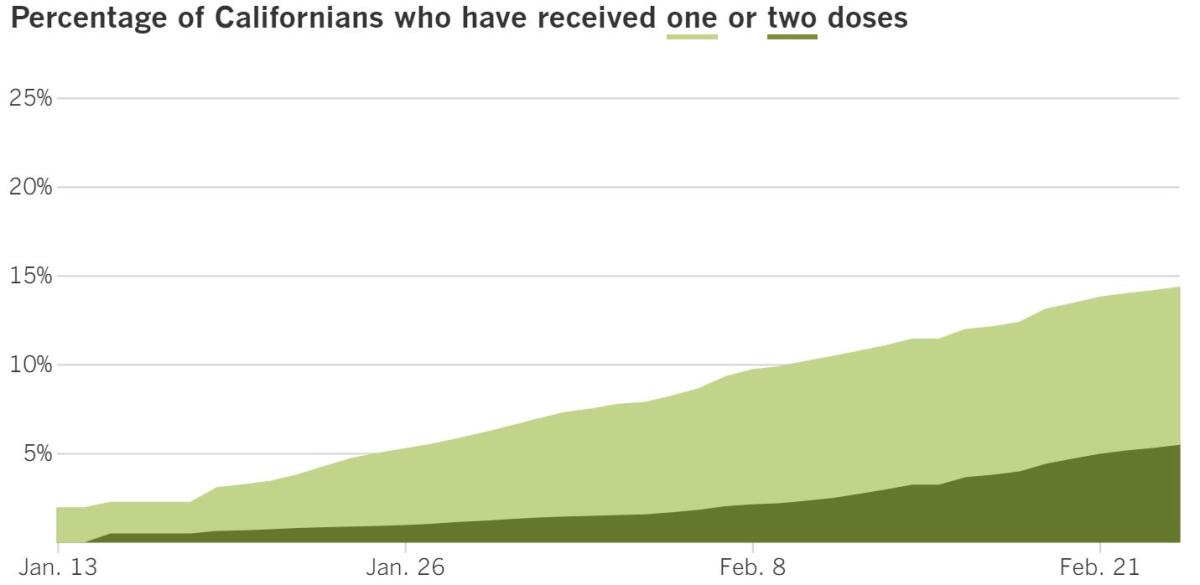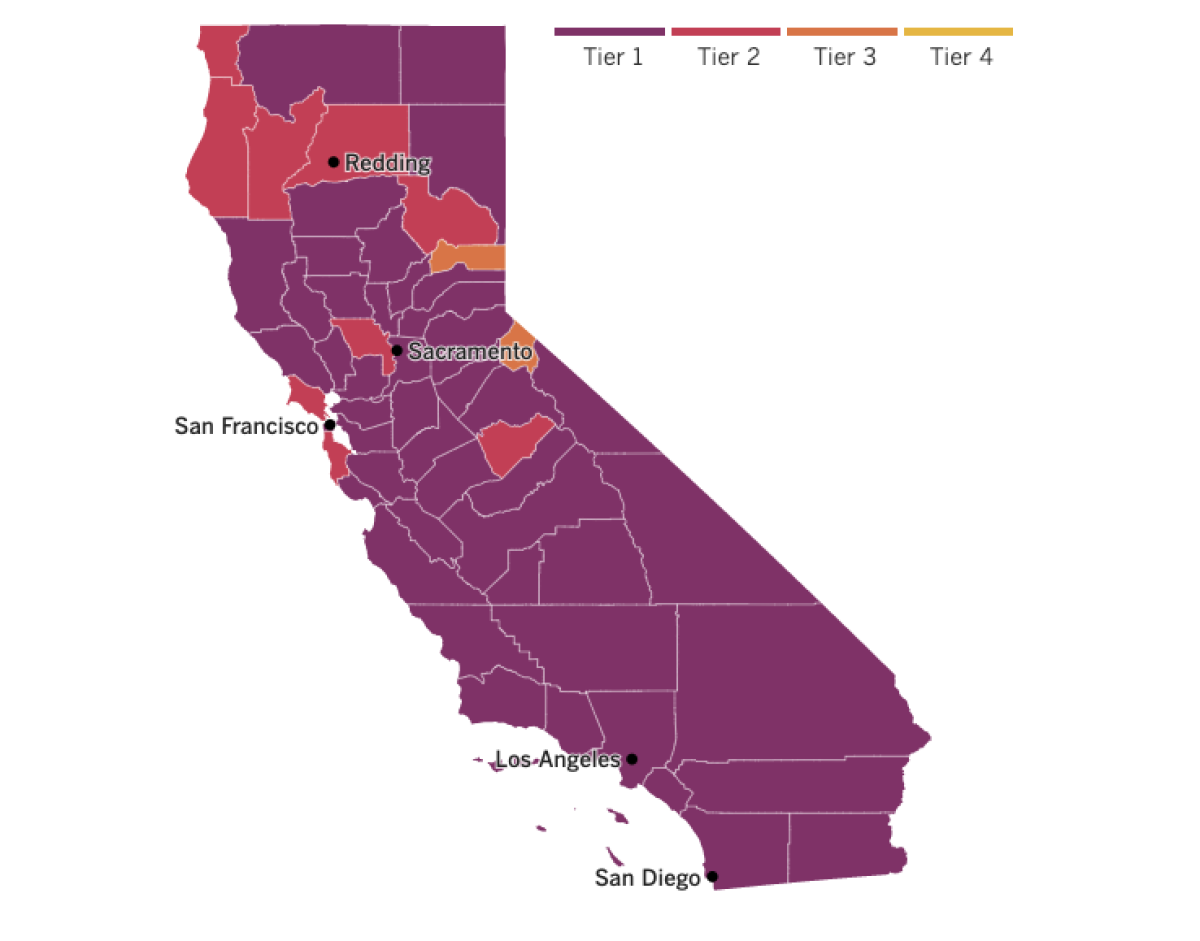Coronavirus Today: Rediscovering life’s rhythms
Good evening. I’m Thuc Nhi Nguyen, and it’s Thursday, Feb. 25. Here’s what’s happening with the coronavirus in California and beyond.
Becoming vaccinated against COVID-19 doesn’t earn a no-mask pass, but it can provide some long-awaited peace of mind.
For elderly people who spent most of 2020 petrified of developing a severe case of COVID-19 and healthcare workers who feared being infected while on the job, getting immunized has meant rediscovering the old rhythms of the world, my colleagues Maura Dolan and Alejandra Reyes-Velarde report.
Luis Parocua Jr. saw the pandemic from the front lines as a technician sterilizing surgical instruments at Huntington Hospital in Pasadena. He had nightmares about the devastation he saw at work. But now the 65-year-old who retired late last year sleeps easier — and even dined outdoors at a barbecue restaurant — after getting his second shot.
“It feels good,” he said. “If I go out there and I get sick, at least I know I’m not going to die.”
The calculus for socializing has changed. Shelley O’Connor, a 67-year-old Walnut Creek resident, signed up for online dating in December but mostly met potential matches for masked hikes. She recently went on a hike and picnic with a college professor who, like her, had received his first dose. By their next date, both will be fully vaccinated.
“I think life can be back to normal when you are talking about what two vaccinated people can do together,” said Dr. Robert Wachter, professor and chair of the Department of Medicine at UC San Francisco.
Experts are also getting comfortable returning to old habits, including Dr. Robert Kim-Farley, a UCLA medical epidemiologist who received a second dose of the Pfizer vaccine last week. He’ll be going to the grocery store every few days now instead of twice a month. But he’s not pulling his grandchildren in for hugs just yet.
The Centers for Disease Control and Prevention still advise vaccinated people to follow guidelines such as maintaining physical distance and wearing a mask because it’s unclear whether inoculated people without symptoms could still be infected and spread the virus. Also, there are uncertainties about how long vaccine protections last.
Though vaccinated people get glimpses of normal life, not everything is free rein. Vaccinated people are not exempt from the CDC’s travel guidelines that advise against unnecessary travel, and federal rules require even vaccinated travelers to show negative coronavirus test results before returning to the U.S. from abroad. Still no indoor dining or movie theaters either, my colleagues report in their Q&A of recommendations for vaccinated people.
Officials are waiting for case rates to fall further before those activities will be deemed safe. Considering the many twists of the past year, it’s best to stay vigilant.
“It isn’t over until it’s over,” said Alice Liston, a 30-year-old Berkeley home health aide.
Tell us: What are you most looking forward to doing after you and your loved ones are vaccinated? Email us, and we may feature your reply in a future edition of the newsletter.
By the numbers
California cases, deaths and vaccinations as of 5:23 p.m. Thursday:

Track California’s coronavirus spread and vaccination efforts — including the latest numbers and how they break down — with our graphics.

Across California
Southern California’s holiday surge was even deadlier than previously thought: On Wednesday, one day after its death toll surpassed 20,000, L.A. County identified 806 additional COVID-19 deaths from December and January, when hospitals were overwhelmed with patients.
The county typically relies on reports from healthcare providers to count COVID-19 deaths and supplements those tallies by checking the causes of death listed on death certificates. The additional fatalities — which account for about 8% of all the county’s COVID-19 deaths in those months — turned up during one of those audits.
“This was a period, as you all know, where very many deaths occurred across the county,” L.A. County Public Health Director Barbara Ferrer said. “And not all of them were reported to [the Department of] Public Health because of the volume of records.”
Despite the sudden jump in fatalities, many key coronavirus metrics are improving in L.A. County. The number of new cases per day has dropped 87% since early January, and deaths per day declined by 50%. The county’s test positivity rate, which exceeded 20% around Jan. 1, is now below 5%.
Many of the restrictions that were implemented to get to this point have been met with ire, including closures of bars and restaurants and limits on gatherings. Now, county rules and enforcement are driving a wedge between the county Public Health Department and the city of West Covina, my colleague Kevin Rector reports. The West Covina City Council voted this week to begin the process of forming its own health department, saying the county had failed residents and hurt businesses.
Going rogue to avoid the regulations of a large health department may seem appealing to many small cities. The pandemic has had profoundly different impacts across the nation’s most populous county, so having a more regionalized approach could be effective. Indeed, Pasadena and Long Beach operate under their own health departments. But replicating those efforts will be much different for West Covina, which covers 16 square miles and has about 110,000 residents.
The city will have to get the state’s sign-off on its own health department before it can be free from L.A. County’s regulations. That will include taking on tasks such as recording birth and death certificates, controlling communicable diseases, maintaining environmental health and sanitation, providing maternal and child health and nutrition, and fighting chronic diseases, among other things.
Mayor Letty Lopez-Viado and City Manager David Carmany backed the plan, citing complaints from residents they said didn’t feel the county’s services met their needs. For Councilman Brian Tabatabai, the lone dissenter in the 4-1 vote, the plan didn’t include enough financial analysis and showed more hubris and misdirected frustration than commitment to service.
“All of the suffering that businesses and residents, all of us, have gone through is not because of decisions of public health departments or governors, it’s because of COVID,” he said. “Prior to COVID-19, we have never had it on the agenda about starting our own public health department. COVID-19 is the problem.”
In L.A., where city-run vaccination sites are kicking back into gear after weather delays, Mayor Eric Garcetti is dreaming of an open door to vaccine access. With vaccine production ramping up, he said Wednesday he believes the priority groups that designate which people are eligible for the vaccine could be a thing of the past in one to two months.
However, until that time, the city is still prioritizing second-dose appointments before March 1, when vaccine eligibility will expand to include workers in education and child care, food and agriculture, emergency services and law enforcement.
In an effort to speed toward reopening schools, California intends to reserve 10% of available doses for employees working in education. Now 40% of those doses in L.A. County will go to the L.A. Unified School District.
County officials and the L.A. County Office of Education calculated the share through a distribution formula designed to help reopen campuses sooner in areas hardest hit by the pandemic. Despite the relatively large number of doses going to L.A. Unified, it’s not close to what officials say they’ll need to reopen elementary school classrooms by early April.
The number of doses sent to L.A. County is expected to rise in the coming weeks, but last week’s allotment of 10,000 doses countywide would have left 4,000 for LAUSD. The school district wants 25,000 employees to have at least their first of two doses by the end of next week to meet its target date of April 9.


See the latest on California’s coronavirus closures and reopenings, and the metrics that inform them, with our tracker.
Consider subscribing to the Los Angeles Times
Your support helps us deliver the news that matters most. Become a subscriber.
Around the nation and the world
Every time a new block of appointments for COVID-19 immunizations open, it can seem like a free-for-all race. Navigating the course is fraught with obstacles such as jammed phone lines and overloaded websites. For those who are visually impaired, finding the finish line can be especially difficult.
In a survey of 94 COVID-19 vaccine websites from all 50 states and Washington, D.C., nearly all had accessibility issues, violating disability rights laws. The websites included general information about COVID-19 vaccines, providers and how to register for an appointment.
Doris Ray, who is blind and has a significant hearing impairment, tried to use screen-reading technology to sign up for a vaccine appointment, but the tool that reads a website’s text aloud didn’t work on the drop-down menu used to select her county. Bryan Bashin, who is 65 and blind, needed help from his sighted sister to sign up for an appointment after he struggled to use an inaccessible website on consecutive nights while others quickly snapped up the available slots. Other visually impaired people relied on apps that allow a sighted person to access their computers remotely.
“I resent that the assumption is that a sighted fairy godmother ought to be there at all times,” said Sheela Gunn-Cushman, who got help through an app to complete preregistration for a vaccine.
Calling phone lines to make an appointment wasn’t an option either. They had long wait times and limited hours compared to websites that are available at 24/7.
Website accessibility problems sometimes come down to programming failures, such as not ensuring enough contrast between text and a page’s background or not putting alternative text on images to explain what they show. Forms from 19 states’ pages were built in a way that prevented screen readers from deciphering what information a user should enter in the search bars of vaccine registration forms.
Ensuring access to reliable information about the pandemic is especially important at a time when as many as 1 in 3 Americans say they definitely or probably won’t get a COVID-19 vaccine. A new public service ad campaign unveiled Thursday aims to convince vaccine-hesitant Americans to get their shots by offering information about the shots in seven languages.
The campaign, led by the Ad Council, tells people, “it’s up to you,” and will feature English and Spanish ads for TV, billboards, bus stops and social media. Celebrities, including Angela Bassett and John Leguizamo, are expected to lend their influence toward the cause.
Converting vaccine hesitancy into confidence takes time, said Jay Winsten, a Harvard University public health communications expert. He said the timing of the campaign is good because millions of Americans have already been safely immunized and others will be more open to receiving messages about vaccines.
While the number of vaccines administered grows every day, so does the lingering suspicion that coronavirus variants could derail recent progress in fighting the pandemic.
Health authorities say first-generation COVID-19 vaccines still protect against the strains that are emerging — but manufacturers like Pfizer are starting to make backup plans just in case. The company has started studying the effects of a third dose of its vaccine and plans to offer it to 144 volunteers to determine if an additional shot given six to 12 months after the first two helps ward off potential infection from newer variants.
The protocols used to fend off the coronavirus are having a side benefit: Experts say prevention measures like mask-wearing, social distancing and virtual schooling doubled as great techniques for fighting the flu this year.
Reports of the flu are at record-low levels. It’s a dramatic — and welcome — change for doctors, since in recent years, the flu has caused 600,000 to 800,000 annual hospitalizations and 50,000 to 60,000 deaths in the United States. Similar drops in flu activity have been reported in the Northern Hemisphere during this flu season, matching reports of quiet flu winters in the Southern Hemisphere.
One Oregon doctor called the situation “beautiful,” but it may also be fleeting. Each season’s flu vaccine is based on research done with samples of strains found during the previous year. Scientists will not have much to go off of for the next round.
Your questions answered
Today’s question comes from readers who want to know: Is it safe to go to the gym yet?
Indoor gyms are a far-off dream for people in counties assigned to California’s most-restrictive purple tier — but five counties moved to the red tier this week, allowing gyms as well as dance and yoga studios there to open at 10% capacity.
If you live in one of those places and your outdoor or home workouts are not cutting it anymore, then returning to an indoor gym is possible.
“I do think many gyms can stay open,” said Dr. Larry William Chang, an infectious disease specialist at the Johns Hopkins University School of Medicine. “But they really need to have some vigorous policies and adjustments in place.”
If strict protocols aren’t followed, things can quickly go awry, my colleague Amina Khan reports.
This week, two research teams detailed coronavirus outbreaks linked to fitness centers in Hawaii and Chicago. Masks weren’t required in fitness facilities in Hawaii at the time, and two infected instructors passed the coronavirus to 20 of the 21 people they encountered through classes or personal training sessions during the 24 hours before they developed their first symptoms of COVID-19. Another gym patron was infected in the 24-hour period before that.
In Chicago, people had to wear masks when they arrived at the gym but could remove them while working out. During a nine-day period, and 55 of 81 people in high-intensity indoor classes became infected.
In the case of the Chicago outbreak, the gym put on a performance of “public health theater,” said Chang, who was not involved in the research. The gym required masks, temperature checks and symptom screenings at the door, had patrons bring their own mats and weights and placed people six feet apart. But to whatever extent those measures may have been helpful, they were undermined by allowing people to take their masks off when classes started.
The lesson?
First, think twice before taking a group class indoors. “I personally would never join a group class in an enclosed space with poor ventilation,” Chang said.
Second, there are plenty of ways for gyms to reduce the risk to their customers. The research teams suggested that gyms enforce consistent and correct mask use and physical distancing, encourage staff and patrons to stay home if they’re ill, and significantly improve their ventilation.
We want to hear from you. Email us your coronavirus questions, and we’ll do our best to answer them. Wondering if your question’s already been answered? Check out our archive here.
Resources
Need a vaccine? Keep in mind that supplies are limited, and getting one can be a challenge. Sign up for email updates, check your eligibility and, if you’re eligible, make an appointment where you live: City of Los Angeles | Los Angeles County | Kern County | Orange County | Riverside County | San Bernardino County | San Diego County | San Luis Obispo County | Santa Barbara County | Ventura County
Practice social distancing using these tips, and wear a mask or two.
Watch for symptoms such as fever, cough, shortness of breath, chills, shaking with chills, muscle pain, headache, sore throat and loss of taste or smell. Here’s what to look for and when.
Need to get tested? Here’s where you can in L.A. County and around California.
Americans are hurting in many ways. We have advice for helping kids cope, resources for people experiencing domestic abuse and a newsletter to help you make ends meet.
We’ve answered hundreds of readers’ questions. Explore them in our archive here.
For our most up-to-date coverage, visit our homepage and our Health section, get our breaking news alerts, and follow us on Twitter and Instagram.




